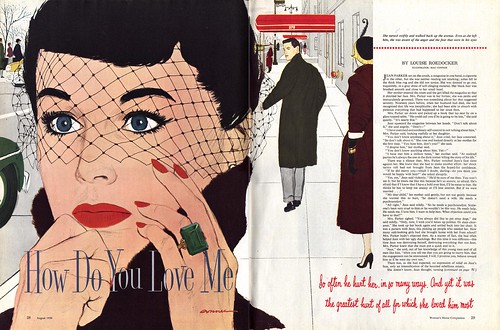Could they have also been looking at comic book art?

Consider this: a comic book artist working in 1950 would have had to draw many dozens of panels over 20 or 30 pages to earn a few hundred dollars. If such an artist had been working on a romance story, any one of those panels might have come out looking very much like this illustration Mac Conner created for the August 1950 issue of Woman's Home Companion. But because Conner was a highly respected illustrator working in a far more "legitimate" wing of the commercial art business, he was paid many hundreds of dollars for just this one panel.
I'm not trying to disparage Conner - far from it - but isn't it interesting that for many people the merit of artwork depends on the context in which it is presented? Many talented comic artists spent their careers toiling in sweatshop conditions, their work beneath notice - beneath contempt - to many people in the broader public. Yet flip open an old comic of the day and scrutinize any single panel and you'll likely find many a composition every bit as accomplished and lovely as the Mac Conner illustration above.
Fast forward another decade and Roy Lichtenstein's super-enlarged comic book panel paintings were selling out at the Leo Castelli gallery in New York before his first one-man show even opened. Ironically, the fine art collectors that paid dearly for Lichtenstein's paintings would have turned their noses up at the thought of framing Mac Conner's original and hanging it on their wall.

It was, after all, just an illustration.
Both of these pieces and a few others can be seen at full size in my Mac Conner Flickr set.
I agree whit you Leif,
ReplyDeletein this specific case there's no big difference between this kind of illustration and the high level that romance comics reached in the 50s. If the first illo in this post was a panel I'd say it's a very good panel (even though the lady's gesture may appear a bit stiff to me).
I'm pretty sure that enlarging some Raymond panels to illustration size we had remarkable results!
Btw thanks for sharing, you have always great art here!
-rz-
I’m totally agree with you Leif, some artists were totally undervalued, btw I love some comics illustrators like John Buscema and Alex Ross and his amazing DC comics artwork.
ReplyDeleteRegards
Very interesting and, in my opinion, valid observations, Leif. Line and flat color in comic books, was faster to render and reproduced well... under lesser quality paper stock and mass printing conditions.
ReplyDeletePerhaps, it was therefore considered by the general art community, as a "lower form" of illustration. And, as you alluded to, maybe a few innovative illustrators saw the comic book technique as an effective valid approach, a change of pace and a more avant garde story illustration.
As a kid, I recall the beautifully illustrated, Hal Foster illustrations for "Prince Valiant" in the sunday papers. They were as well drawn, composed and rendered as anything in the top magazines of the day.
Recycling ideas, approaches and techniques in art, has always been part of the evolutionary process of the history of art. And why should illustration be any different?
Comic book artists are not respected enough and not taken seriously enough - and that's wrong. There's a similar disrespect for animation - many people with the narrow, incorrect thinking that if it's animated then it's a cartoon and therefore only for children...
ReplyDeleteBack to comics, http://www.comicspace.com/ is a wonderful site, and artists can create a free portfolio of their comics, cartoons, and illustrations.
Interesting points - but I wonder if it might as easily be vice versa - that comic artists were/are influenced/inspired by other 'pop' graphic arts - & fine arts as well....?
ReplyDeleteGood point, ctb59 - no doubt it goes both ways.
ReplyDeleteActually, at that particular point in time I highly doubt "legitimate" illustrators like Mac Conner looked at comic book art. Comic strip art, no doubt - but comic book art was really considered to be trash in those days. So much so that some artists avoided telling people what they did for a living, believe it or not.
By contrast, comic strip artists were revered as celebrities.
Adding injury to insult, Lichtenstein swiped his panels from comics drawn by other artists.
ReplyDelete